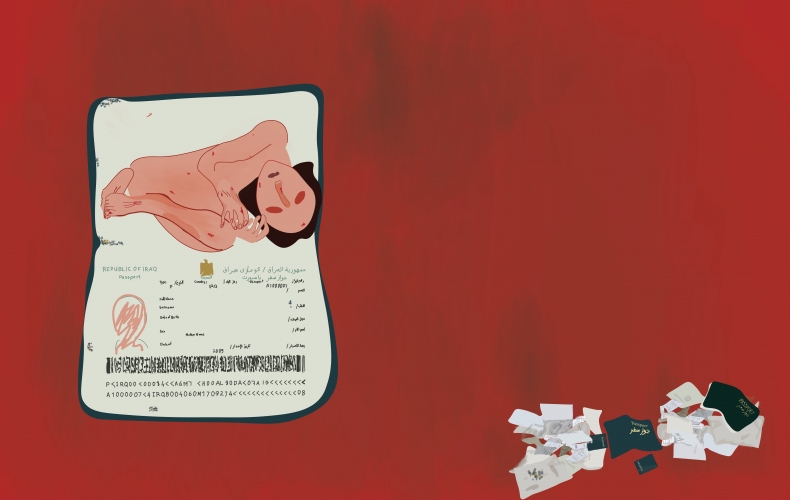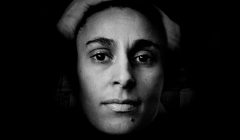The illustrator and storyteller Hayfaa Chalabi writes and draws about what kind of design the Migration Board uses to visualize the asylum process. She tells about her own asylum experience and the roles that refugees are forced into. The work becomes a place for memory and history writing where Chalabie tries to understand how to document a process that is prohibited to be documented by the person undergoing it. How and why is the same emotion, such as fear, expressed and processed differently depending on one’s possibilities or impossibilities?
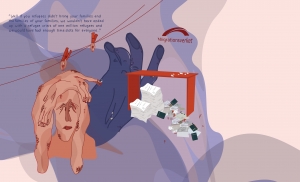
The last time I visited the migration office at Sundbyberg to make an appointment for a travel document application, I was welcomed with a voice of reproach from the receptionist. In a crisp sentence, he laid out a trifecta of fear, hate, and punishment – elements that sum up the so-called ‘’refugee crisis’’. His response was: ‘’Well if you refugees didn’t bring your families and the families of your families, we would not have ended up with a refugee crisis of one million refugees. We would have had enough time slots for everyone’’. Having to encounter that attitude for ten years as an asylum seeker made me realise that this apathetic answer is structural.
As he blamed me for being part of a number that should not have exceeded the planned political maintenance of refugee statistics in Sweden, let’s not sugar-coat this institution’s attitudes. These are patterns beyond a worker having a bad day or a mean migration officer. Acknowledging this is significant in deconstructing the understanding of refugees’ positions in the Swedish society.
It is not the first time people label me as a “problem’’. The refugee has always been a crisis, “A global refugee crisis’’, “An integration crisis’’, and a “European migrant crisis’’. According to most Western countries, the refugee is an international crisis. Therefore I ask, are refugees really welcome?
To answer this question, let us first decide upon a definition of the term: refugee. Who can get asylum in Sweden, who is worthy of becoming a Swedish citizen and who is not? There are two aspects to consider; an institutional definition and a moral analysis of such a definition.
According to the United Nations High Commissioner for Refugees (UNHCR) Sweden, ‘’a refugee is someone who has been forced to flee his or her country because of persecution, war or violence. A refugee has a well-founded fear of persecution for reasons of race, religion, nationality, political opinion or membership in a particular social group’’¹. This definition is limited to certain conditions. For example, the economic migrant is constructed as the binary opposite of this understanding of the refugee, as UNHCR Sweden states that the economic migrant ‘has a choice’². This statement suggests that the economic migrant chooses to move not because of a direct threat of death but rather to improve their lives by finding a job. Unlike refugees who cannot safely return home, migrants face no impediment to return. Therefore, an economic migrant can make a choice of returning to their country without being under a threat of persecution or death. The discursive legitimization of a refugee that fits well with the refugee convention and the international refugee law is one that includes people who had to escape a conflict, a war, or a threat of prosecution. With this definition, the asylum seeker who ticks the box of being a refugee according to international law, must still prove their case. They must go through a series of interrogations by the Migration Board, a process of justification for why they deserve a status that is almost never believed.
If you do not play the role expected of a refugee, you will not qualify as one, even if that is what you are. On the other hand, if you play that role, you are eventually a threat to the country, a threat that the migration institution fears.
Yes, they fear us!
To have a chance to get a refugee status in Sweden, you are obliged to conform and adjust your life story to not only a Eurocentric judicial language but also a Eurocentric sympathetic language that provokes the saviour complex and grants you a status. There are certain roles expected of a refugee; to be sad, to be traumatised, to be miserable and to be consistent with their story. One of the most popular pieces of advice one gets as an asylum seeker is to cry during the investigation meetings with the Migration Board. As if sadness could only be translated into tears. Your mission is a very tricky one. You are playing on a blurred line between conveying sympathy that victimises you but grants you an exile and conveying a too unrelatable struggle. A struggle that might not awaken the saviour complex but rather awakens fear of a lying ‘other’. The lying other is undesirable and thus, must not be granted a status. So be miserable but not too miserable.

I started making my illustrations as an outlet for my sadness and anger. They were documenting what was not allowed to be documented. While the design and power structures inside the migration office in Sundbyberg suggested the deprivation of my right to document or record whatever happens in that space, my words and illustrations are a tool of recognition and representation. Waiting processes lead to Resignation Syndrome³. Deportation decisions lead to trauma and heart attacks4. These are the stories lurking in the minds of hopeful refugees. Therefore, telling more stories of migration processes becomes crucial. As an asylum seeker myself, I would like to propose a narrative that is not written or illustrated by nor for institutional understanding. Instead multiple narratives that are told by asylum seekers and for cultural understanding. I would also like to highlight my privileged position as an asylum seeker who has a permanent residence and be critical of my visit to some stories as a storyteller.
But what about the role of the Migration Board in narrating and designing our stories as refugees? I believe it is of high importance to deconstruct how design executed by an institution, such as the Migration Board, impacts the situation of the refugee in Sweden.

In 2011, one year after I arrived in Sweden at age 13, the Migration Board commissioned the creators of Bamse, a famous children comic book, to make an issue on migration in Sweden. The well-known cartoon character Bamse who often promotes values such as equality, was playing the role of a migration officer addressing the children seeking asylum in Sweden. Bamse’s role was to clarify that the children who get deportation decisions would be in safe and warm hands in their homelands and that deportation is a natural happy process and outcome of migration5.
Deportation in this comic is presented as a situation that provokes irrational stressful emotions in asylum seeking children. This in turn enforces the motive of accepting deportation as a natural part of migration.
The banal depiction of the comic comes off to me as an ironic one. What strikes me most is that this design is claimed to be made for asylum seeking children. In contrast, I would like to present the stories that are truly our references.
As a refugee and an asylum-seeking child myself, my references were often situations of real life that I saw as a possible consequence to the decisions I might face by the Migration Board. The story that circulated most between refugees was about the Iraqi man who got a deportation decision. On the plane to Iraq he had a heart attack and died before arriving to a future his mind and body could not bear. While Bamse’s story depicts a warm and beautiful welcoming of the refugees once they arrive in their homelands, the last words of the dead Iraqi man were ‘‘I have no life there. No home, no family, nothing. My future is here’’6.
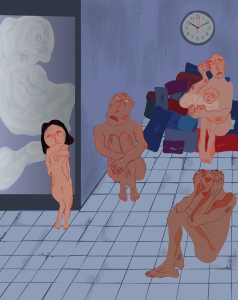
The Iraq War left its people with almost one million orphans7. The banal assumption that all refugee children have a home to go back to and a family waiting for them, makes it obvious that this comic is not made for refugee children. Hiding multiple truths, the Migration Board chooses to make, in collaboration with Bamse, a visual representation that creates a false reality of how the government deals with presenting its immorality of child deportation, and feeds this narrative to its new generations.
The Iraqi man’s incident was not the first nor the last. In the same year as Bamse’s comic was issued, another Iraqi man, Khaled Khodidi, died shortly after he was sent back to Iraq. Khodidi had to bid farewell to the members of his family in Helsingborg and go to a country where nothing awaited him but his death. Khodidi has shortly after his deportation his head cut off, leaving his six-year-old son as an orphan8.
Another incident that reveals the cruelty of deportation is the tragic story of the 13-year-old Abdullah. After their deportation from Sweden, Abdullah and his family sought asylum in Italy and had to sleep in the streets at night, leading to their son’s death9. Seated in a wheelchair due to his muscle dystrophies, Abdullah died in the streets of Bolzano in Italy, after falling off his chair and receiving no medical assistance.
Why is our death significantly less feared than our threat to refugee statistics?
What happens when the state denies your case and does not believe it – when the migration officers smile at you as they inform you of your deportation? What happens when the state depicts your death as a natural happy ending to your migration process? It sends a message to all refugees: our lives do not matter.
Around the year 2014, I got a deportation decision.
At the age of 17, the Migration Board decided I should be sent off to an orphanage in Iraq, the land of the million orphans. By that time, I was trying to adjust my whole life to suit the claimed politics of asylum in Sweden in a way that would make the Migration Board grant me a status.
I was desperately trying to understand and evaluate the crisis in the country. At that time, Sweden was shifting from a “refugee crisis’’ to an “Integration crisis’’. Flyktingkrisen or the Refugee crisis was the term used to represent the sharp increase in the number of asylum seekers during the second half of 2015. The term was later changed by the UNCHR to “The Global Refugee Crisis”, probably a less Eurocentric term.
The sharper decrease in the number of refugees entering Sweden from early 2016 onwards turned the Global Refugee Crisis in the country to a background noise rather than a genuine concern. What political state led to this significant decline in such a short time? The answer comes with the strict regulations that Sweden used to limit the number of immigrants entering the country at that time. Border controls between Sweden and Denmark were heightened in early 2016 as all travellers’ passports were checked by border security guards. This came simultaneously with a striking increase in polls for the Sweden Democrats party (SD), the party that has roots in Sweden’s neo-nazi movement. The support that rose to 22% came at the end of the year 201510, the same period that marked the sharp peak in asylum seekers entering the country. In some polls, the Sweden Democrats (SD) became the second biggest party in the country. The support for the party declined later in 2016 as the number of refugees and asylum seekers decreased.
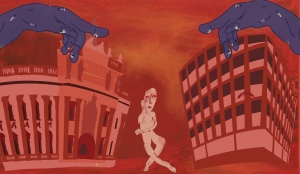
I believe that the power of discourse shapes the way we perceive and consume the identity and position of the refugee in our society. When I think about discourse and terminology, I cannot avoid thinking about the label “The Migration Board’’. Sweden does not have an institution that exclusively processes refugee cases. It is the Migration Board that is also in charge of refugee applications. Giving refugees the ‘’Immigrant’’ label does not only deprive them of their recognition in Sweden. Calling refugees immigrants and nothing but immigrants turns a blind eye to the refugee’s journey, history and struggle which are crucial to their identity and migration case.
The term migrant, that is often used to describe refugees in Sweden and the West, is a word that is far from describing the refugee. Imagine an average middle-aged Swedish citizen, who has a job with a decent salary, a small family and a stable life. They get slightly bored and decide to look for a new life adventure, thus move to Spain for a new job position, that is an immigrant.
A refugee is someone who in most cases flee war with no chances of going back. It is someone who might have had to strap their body into a life jacket and cross seas seeking survival only to come to countries that do not even give them recognition starting with the institutions that process the refugees’ asylum applications.
The misuse of terminology when describing refugees is wisely applied in far-right commercials against refugees in Sweden. A tool that creates fear between groups, which in turn results in segregation. In September 2010, the Sweden Democrats (SD) published a commercial of two groups running towards the state budget. One of them being old, white Swedes and the other, a group of women in niqab labelled as ‘’Invandrare’’ immigrants. The second group runs faster leaving the viewer no other choice but refusing the invading other who takes all the government budget¹¹. The ad clearly divides our society in two groups; a vulnerable one who tries to preserve its rights in its own country and a threatening one who rips the Swede off their money, stability, and security. The group represented under the label ‘’Immigrant’’ in this ad is all covered. This is significant as the more we do not see or know who or what to fear the more the world becomes frightening. We cannot deny that this kind of ad creates fear in the refugees themselves as they are recognized as objects of threat to the society and thus denied their identity, history, and thought.
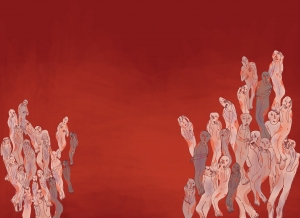
Fear works to restrict certain bodies. Generally, when one fears, the body shrinks to avoid the threat that creates this emotion. This shrinkage is significant as it causes certain bodies to take less space in society. On the other hand, the nationalists’ fear extends their bodies and urges them to embrace their inhabitancy. This happens as a demonstration against any invasion that might mark the occupation of any spaces in that nation.
The illustration of threat and fear continued to exist in ads created by SD for the election in 201612. The commercial, Tid För Sverige, (Time for Sweden) depicts Sweden as a country that suffers from severe hardship due to the other who invades and threatens the initially safe and economically stable nation.
After analysing the fear designed in those ads, I can understand the fear the Migration Board has of me. As I entered the migration office in Sundbyberg, I realised that our stories threaten the narrative of the scary refugee and therefore, we must remain silent! The history of refugees in Sweden is a history that most of the time is told by parties that refuse to recognize the refugee. This in turn continues to govern and alienate not only the body of the refugee in Swedish society but also their right to representation and recognition. I was overwhelmed by signs that order me not to document or tell my story outside the migration office. I became extremely curious of why residents from the so-called ‘’developing countries’’ who have no international privileges whatsoever are feared and thus prohibited from documenting anything that happens to them inside this institution. I now understand that the Migration Board is afraid of our power to tell stories outside the walls of its offices. Storytelling here is a tool that serves an aim beyond its practical aspect of narrating. It is a resistance against the restrictions of filming, recording, and photographing our history. It is a significant tool that educates, witnesses, and re-contextualises the right of refugees to tell their own stories and document a history that is only told by our oppressors. It is crucial to write and draw in protest against their attempts to silence and alienate our stories. Words and illustrations become tools of memory, histories and resistance that say: “Despite your attempts to silence me, I am loud and still here!”
References:
-
What is a Refugee? Definition and Meaning: USA for UNHCR. (n.d.). Retrieved from https://www.unrefugees.org/refugee-facts/what-is-a-refugee/.
-
United Nations. (n.d.). ‘Refugees’ and ‘Migrants’ – Frequently Asked Questions (FAQs). Retrieved from https://www.unhcr.org/news/latest/2016/3/56e95c676/refugees-migrants-frequently-asked-questions-faqs.html.
-
Aviv, R. (2019, July 9). The Trauma of Facing Deportation. Retrieved from https://www.newyorker.com/magazine/2017/04/03/the-trauma-of-facing-deportation.
-
Sveriges Radio. (n.d.). Personalen berättar om utvisning där irakisk man dog – Nyheter (Ekot). Retrieved from https://sverigesradio.se/sida/artikel.aspx?programid=83&artikel=6126233.
-
Bamse och Migrationsverket. (n.d.). Retrieved from https://bloggar.aftonbladet.se/kulturbloggen/2011/05/bamse-och-migrationsverket/.
-
Åkesson, H. (n.d.). Dog vid utvisning till Irak: “Ni skickar mig i döden”. Retrieved from https://omni.se/dog-vid-utvisning-till-irak-ni-skickar-mig-i-doden/a/a17bdb64-7644-43bb-93c5-acb456f86ee4.
-
Hawley, C. (2012, November 28). Iraq conflict: Crisis of an orphaned generation. Retrieved from https://www.bbc.com/news/world-middle-east-20461110.
-
Helsingborg, O. D. C. (2011, November 2). Dödad efter utvisning till Irak. Retrieved from https://www.hd.se/2011-11-02/dodad-efter-utvisning-till-irak.
-
Kudo, P. (2017, October 13). Svårt sjuk pojke nekades asyl i Sverige – dog i Italien: SvD. Retrieved from https://www.svd.se/svart-sjuk-pojke-nekades-asyl-i-sverige–dog-i-italien.
-
SVT Nyheter. (n.d.). Väljarbarometern. Retrieved from https://www.svt.se/special/valjarbarometern/.
-
(n.d.). Retrieved from https://www.youtube.com/watch?v=XkRRdth8AHc.
-
(n.d.). Retrieved from https://www.youtube.com/watch?v=4tXeGGpD0Ac&t=28s.
Cover image Where are you from? by Hayfaa Chalabi
Visual description: an illustration that visualizes an identity struggle and the refusal of certain institutions and communities to accept a new citizen.

